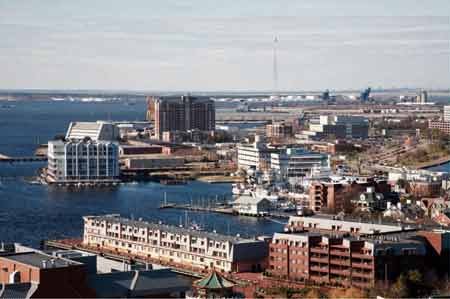Report Courtesy of Urban Land Institute
By taking steps to strengthen its resilience to rising sea levels and other impacts of climate change, the City of Norfolk can also improve its economic stability and overall quality of life, according to a report issued by a panel of nationally renowned land use and urban planning experts convened by the Urban Land Institute (ULI).
Conducted through ULI’s advisory services program, the panel visited Norfolk December 14-19 to advise the city on improving the resilience of the Fort Norfolk neighborhood, one of the most strategically located waterfront urban sites on the Atlantic seaboard. The report, Norfolk Virginia: Assessing Risk and Protecting Value, builds on initial recommendations made by the panel to the city at the conclusion of its work in December. While the report focuses on Fort Norfolk, it notes that the recommendations made for that neighborhood could apply to other areas of Norfolk that are equally or more vulnerable to frequent flooding from severe weather-related events.
The report was presented today to members of ULI Hampton Roads by panel participants Paul Moyer, director of planning for Vanasse Hangen Brustlin in Vienna, Virginia; and Chuck Schilke, senior lecturer in the Edward St. John Real Estate Program at the Johns Hopkins Cary Business School in Baltimore, Maryland and Washington, D.C.
The ULI representatives evaluated many aspects of waterfront resilience and redevelopment, including the best ways to use land that borders the waterways to ensure that the city can withstand tidal and inundation flooding for the next 50 to 100 years. Among the factors considered: the market potential of the area, given future demographic, population, economic and environmental shifts; preserving public access to the waterfront; land uses that promote long-term value of the development; the impact of tidal flooding on site marketability; land use techniques to improve resilience and incentives to encourage use of the techniques; and using resilient development strategies to help de-concentrate poverty and promote social equity.
The panel recommendations include:
Encourage transit-oriented development – Locating housing and jobs near transit fosters resilience through the diversity of transit options. It also improves the economic opportunities for the region while reducing transportation costs for residents. Specifically, the panel suggested focusing any new development in the Fort Norfolk neighborhood to be near the Tide Light Rail Station, drawing activity into the area.
Provide open space at the water’s edge – Open space paired with temporary and low-intensity uses (such as bike trails and other recreational uses) at the water’s edge can fill the community’s need for interaction with the waterfront while avoiding the cost and risk of permanent development. Well-designed green infrastructure can serve as a community amenity that enhances livability and sustainability.
Activate the site – Implement programs and policies to create energy and momentum for the area, which will help further establish a neighborhood identity while providing low-cost ways to catalyze economic development and open up the waterfront to the residents.
Create a diversity of housing and jobs – Creating a diversity of opportunity for housing and jobs in the Fort Norfolk neighborhood will provide resilience against economic shocks that disrupt any one sector or group. In addition, creating opportunities to build social cohesion provides a fabric of support throughout the community during adverse events.
Create new economic clusters – New economic clusters are needed to attract jobs and investment from outside the region and provide further resilience to economic downturns. These hubs should project an image of the region as one that is transforming itself to become more vibrant, prosperous and livable, and as a result, more sustainable.
Now in its 67th year, the ULI advisory services panel program assembles experts in the fields of real estate and land use planning to participate on panels worldwide, offering recommendations for complex planning and development projects, programs and policies. Panels have developed more than 600 studies for a broad range of land uses, ranging from waterfront properties to inner-city retail.
The ULI panel assignment for Norfolk was part of a series of advisory panels being supported by a generous grant from The Kresge Foundation to advance the institute’s pursuit of urban design and development practices that are more resilient and adaptable to the impacts of climate change. The panel was being sponsored by the City of Norfolk, Urban Design Associates and Work Program Architects.
With the support from The Kresge Foundation, ULI is leveraging the substantial expertise of its members to provide guidance on community building in a way that responds to inevitable climate change while helping to preserve the environment, boost economic prosperity, and foster a high quality of life.
The communities chosen for advisory panel assistance through ULI’s community resilience work are being selected on the basis of 1) the community’s long-range resilience challenges and vulnerabilities to severe weather-related events, and 2) the opportunity for the results to be applied to other communities with similar vulnerabilities.
In addition to panel members Moyer and Schilke, the Fort Norfolk panelists were: panel chairman John McIlwain, a former ULI senior resident fellow who is a consultant on housing and urban resilience and a senior advisor to the Jonathan Rose Companies in New York City; John Macomber, senior lecturer of business administration, Harvard Business School, Boston; Jonathan Miller, president and chief executive officer, Miller Samuel, Inc., New York City; David A. Stebbins, AICP, vice president, Buffalo Urban Development Corporation and senior project manager, Erie County Industrial Development Agency, Buffalo, New York; and Juvarya Veltkamp, manager, Green Economy Initiatives, Vancouver Economic Commission, Vancouver, British Columbia.




